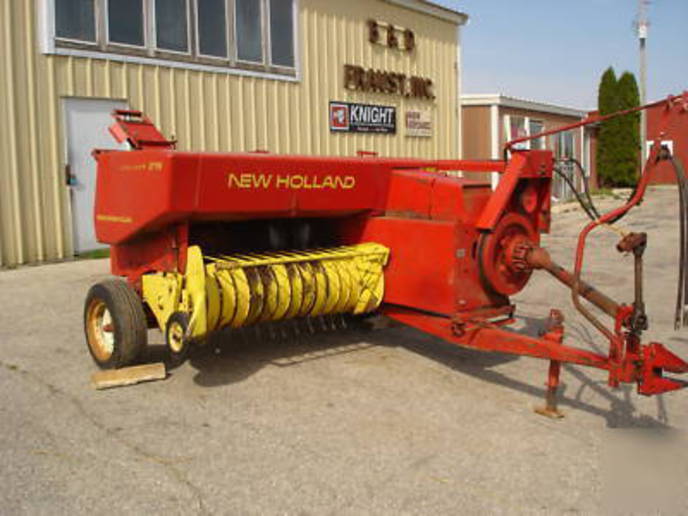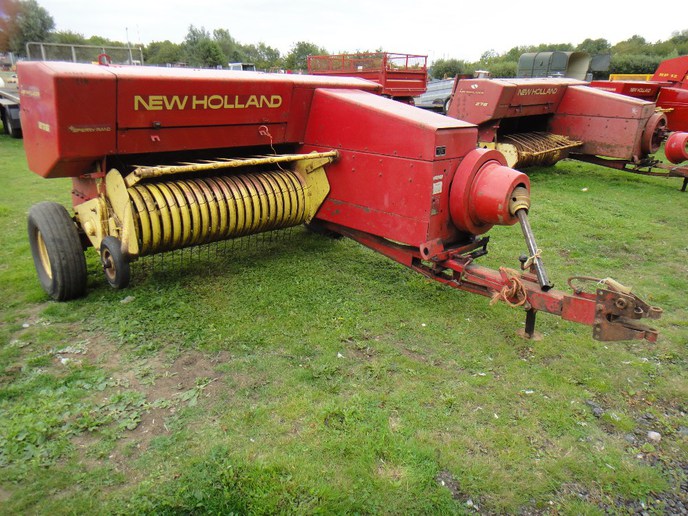lastcowboy32
Well-known Member
We have a small group of dairy cows, and we've purchased hay, or borrowed a friend's baler (NH 269) up until now.
A friend of mine found a 276 at a farm that sold their cows about two years ago. It sat around until now.
He bought it and brought it up to our farm to try. He knew that I was sort of looking for a baler with no thrower, as we only have a small tractor. A baler, kicker and wagon are a little heavy for it. This is a 276 in decent condition with no thrower, no rear tongue hookup for a wagon and an output tray for the bales to slide off of. Something that not many people, other than myself, would want.
Anyway, I greased every fitting that I could find and turned it over gently. As it turned over with the tractor idling, I coated all of the chains with WD-40 as they turned.
Everything sounds good, but it has a short squeal sound that seems to be timed with the plunger. It's loudest if you put your ear by the bottom of the plunger chamber near the tire on the plunger side of the baler. The squeal comes and goes. It isn't there on every plunger cycle. When it is there, it lasts only a fraction of the plunger cycle.
I ran a few bales through it, after stringing with new twine. It seems that, to make square bales, it needs the right (twinebox) side chamber clamp about 15 turns (by thread count) looser than the other clamp in order to make a square bale. I'm thinking that the "dinosaur teeth" may have worn a little short on the tray feed...or the tray feed needs to be adjusted further towards the chamber to pack the far side of the bale more.
It made a few knots just fine.
I also noticed (or I think I noticed) that the plunger tempo, pickup speed and feed tray speed is higher than the older 269 that I'm used to? I chalked that up to the 276 being a much higher capacity baler. Does that make sense?
When I lifted the cover on top of the plunger chamber (just behind the flywheel) to look for grease fittings, I found one on the plunger arm that appears to be designed to have a tube on it that goes somewhere else. It's a little L shaped fitting mounted on the plunger arm. When I put grease in the fitting, it just came out the other side of the L, right on the surface of the arm...I'm thinking that it's missing a tube there that goes...where???
Any comments people? I'm getting a manual, but some comments would be appreciated if any of what I wrote above rings a bell with anyone.
Thanks!
A friend of mine found a 276 at a farm that sold their cows about two years ago. It sat around until now.
He bought it and brought it up to our farm to try. He knew that I was sort of looking for a baler with no thrower, as we only have a small tractor. A baler, kicker and wagon are a little heavy for it. This is a 276 in decent condition with no thrower, no rear tongue hookup for a wagon and an output tray for the bales to slide off of. Something that not many people, other than myself, would want.
Anyway, I greased every fitting that I could find and turned it over gently. As it turned over with the tractor idling, I coated all of the chains with WD-40 as they turned.
Everything sounds good, but it has a short squeal sound that seems to be timed with the plunger. It's loudest if you put your ear by the bottom of the plunger chamber near the tire on the plunger side of the baler. The squeal comes and goes. It isn't there on every plunger cycle. When it is there, it lasts only a fraction of the plunger cycle.
I ran a few bales through it, after stringing with new twine. It seems that, to make square bales, it needs the right (twinebox) side chamber clamp about 15 turns (by thread count) looser than the other clamp in order to make a square bale. I'm thinking that the "dinosaur teeth" may have worn a little short on the tray feed...or the tray feed needs to be adjusted further towards the chamber to pack the far side of the bale more.
It made a few knots just fine.
I also noticed (or I think I noticed) that the plunger tempo, pickup speed and feed tray speed is higher than the older 269 that I'm used to? I chalked that up to the 276 being a much higher capacity baler. Does that make sense?
When I lifted the cover on top of the plunger chamber (just behind the flywheel) to look for grease fittings, I found one on the plunger arm that appears to be designed to have a tube on it that goes somewhere else. It's a little L shaped fitting mounted on the plunger arm. When I put grease in the fitting, it just came out the other side of the L, right on the surface of the arm...I'm thinking that it's missing a tube there that goes...where???
Any comments people? I'm getting a manual, but some comments would be appreciated if any of what I wrote above rings a bell with anyone.
Thanks!





